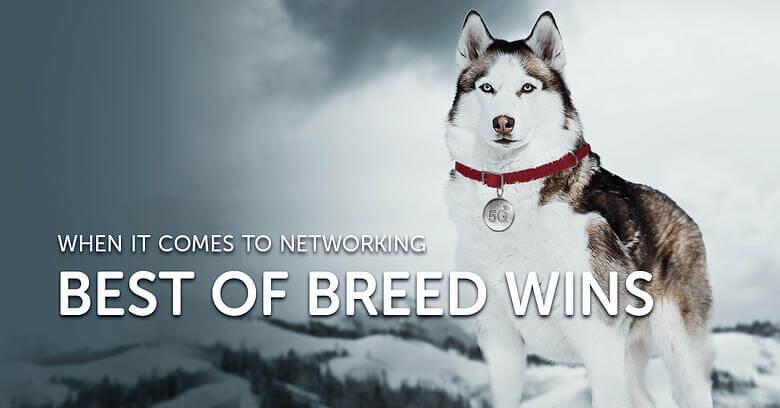Network infrastructure is a strategic asset for any service provider. It is the main enabler for any service provided to end customers and the key enabler for maintaining a successful business plan in today’s ultra-competitive environment.
Any decision about infrastructure evolution, and particularly 5G network evolution, directly affect the service provider’s business – both in the top and bottom lines. It clears the way for new services and revenue streams and significantly influences operational efficiency, defining the total cost of ownership vs. performance and capabilities.
Looking at today’s mobile networks, a multi-vendor networking strategy with best-of-breed solutions is a common approach for achieving results that enhance network and business performance while reducing technology and supply chain dependencies. The interest in best-of-breed solutions is nothing new, of course, and most service providers today operate heterogeneous networks, often comprising a large variety of network equipment provided by various vendors.
Even though best-of-breed poses some planning and integration overhead, it is negligible compared to its delivered benefits of innovation, performance, flexibility, and cost-efficiency vs. all-in-one (bundled) solutions. Best of breed offers far more extensive features and functionality to address specific networking challenges than those offered by single vendors. Moreover, compromising for a “good enough” rather than the best solution can lead to lost revenues and missed opportunities. And with best-of-breed solutions in place, it is much simpler and more cost-effective to continue developing and upgrading network infrastructure.
Today’s reality is that the complexity and scale of the 5G ecosystem make a best-of-breed approach optimal not just for LAN, data center, mobile backhaul and BSS solutions but across all IT systems and now into the RAN.
5G use cases in various verticals and industries require many novel technologies, including network slicing and virtualization, to support three generic services: enhanced mobile broadband (eMBB), massive machine-type communications (mMTC), and ultra-reliable low-latency communications (URLLC). Service providers are looking for solutions that will allow them to unlock their 5G business potential, launch new services, and address new target markets. As a result of it, a new wave of vendors is required to get this 5G vision off the ground and build a software-defined infrastructure capable of delivering critical services.
In the networking space, a few companies stand out. Altiostar provides a 5G-ready virtualized RAN software solution, while Parallel Wireless is offering 5G/4G/3G/2G cloud-native OpenRAN architecture. DriveNets builds cloud-based networking services that provide cheaper and simpler alternatives to core routing.
5G undoubtedly brings the networking space to the next level by promoting innovation and demanding vertical domain expertise and advanced functionality needed to exploit new niches.
As service providers seek scalability, agility, and flexibility while planning their network evolution towards 5G, a best-of-breed wireless hauling vendor with full vertical integration is better positioned to deliver more benefits over time. Indeed, home-designed chipsets and software enable those vendors to develop or co-optimize products that meet current and future needs. By benefiting from in-house insight, those vendors can support higher frequencies, wider channels, multiple channels, or higher modulation schemes faster and more efficiently.
The disaggregated wireless hauling approach is another good example of how things should be working when it comes to relying on best-of-breed solutions. Implementing the disaggregation concept in wireless backhaul is the latest innovative approach for resolving unique and multidimensional 5G challenges, such as deploying more sites, building much more capacity, and dealing with mass deployment.
Disaggregated wireless hauling includes several elements that are independent of each other. The radio element could be a stand-alone radio or could connect to L2 switches or L3 routers. These switches or routers could be a combination of the networking HW and networking SW elements or any other switching or routing platform. This could not be achieved in the proprietary environment, where the development of the radio, networking HW, and networking SW is highly dependent on each other.
Unlike all-in-one offerings, best-of-breed solutions take innovation to a new level by building their product through the lens of better technology, thereby becoming the de facto choice of many service providers. Gartner recommends that “IT leaders should never rely on a single vendor for the architecture and products of their network, as it can lead to vendor lock-in, higher acquisition costs, and technical constraints that limit agility.” Rather, they should “segment their network into logical blocks and evaluate multiple vendors for each.”
If you are still debating between a best-of-breed and an all-in-one solution, we suggest you address the following questions:
- Do you have the best solution for every single component?
- Do you want to be isolated from the competitive environment?
- Can you impact your product roadmap and innovation at your pace?
- Do you want to lose control over the pricing of hardware?
- Are you meeting your business requirements?
- Are you more comfortable with older, more rigid technologies?
If you keep these questions and your project requirements in mind, you should be well on your way to choosing the best wireless hauling solution – one that is highly functional, innovative, and cost-efficient.
To learn about Ceragon’s flexible wireless hauling solutions


